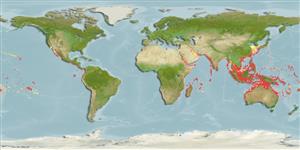Common names from other countries
Environment: milieu / climate zone / depth range / distribution range
Ecologie
marien rifbewoner; diepte 0 - 80 m (Ref. 86942). Tropical; 35°N - 31°S, 30°E - 77°W
Indo-Pacific: from Kwazulu-Natal, South Africa, north to Mie Prefecture, Japan and east to southwestern coast of Baja California Sur, Mexico and Gulf of California to Ecuador (Ref. 9283).
Lengte bij maturiteit / Grootte / Gewicht / Leeftijd
Maturity: Lm 32.5 range ? - ? cm
Max length : 120 cm TL mannelijk / geslacht onbekend; (Ref. 11441); common length : 75.0 cm FL mannelijk / geslacht onbekend; (Ref. 9283); max. gepubliceerd gewicht: 15.0 kg (Ref. 30874)
Dorsale stekels (totaal) : 8; Dorsale zachte stralen (totaal) : 18 - 20; Anale stekels: 3; Anale zachte stralen: 15 - 17.
Adults occur in deep lagoon and seaward reefs where they feed by rooting for crustaceans and fossorial invertebrates in the sand but they also feed on small fishes (Ref. 9710, 90102). Small juveniles live among the tentacles of jellyfish (Ref. 9710). Adults form schools and are also noted for their behavior to closely swim around sharks and other large fishes, and also follow divers (Ref. 10361). Juveniles particularly display this piloting behavior to gain protection from likely predators (Ref. 9710, 90102). Marketed fresh and salted or dried (Ref. 9283). Juveniles are used in the aquarium trade. Minimum depth reported taken from Ref. 128797.
Levenscyclus en paargedrag
Maturities | Voortplanting | Spawnings | Egg(s) | Fecundities | Larven
Smith-Vaniz, W.F., 1995. Carangidae. Jureles, pámpanos, cojinúas, zapateros, cocineros, casabes, macarelas, chicharros, jorobados, medregales, pez pilota. p. 940-986. In W. Fischer, F. Krupp, W. Schneider, C. Sommer, K.E. Carpenter and V. Niem (eds.) Guia FAO para Identification de Especies para lo Fines de la Pesca. Pacifico Centro-Oriental. 3 Vols. FAO, Rome. (Ref. 9283)
Status op de Rode Lijst van het IUCN (Ref. 130435)
CITES (Ref. 128078)
Not Evaluated
Gebruik door de mens
Visserij: van minder commercieel belang; Aquacultuur: commercieel; sportvis: ja; Aquarium: Commercieel
Tools
Speciale rapporten
Download XML
Internetbronnen
Estimates based on models
Fylogenetische diversiteitsindex (Ref.
82804): PD
50 = 1.0000 [Uniqueness, from 0.5 = low to 2.0 = high].
Bayesian length-weight: a=0.01349 (0.01195 - 0.01522), b=2.96 (2.93 - 2.99), in cm Total Length, based on LWR estimates for this species (Ref.
93245).
Trofisch niveau (Ref.
69278): 4.0 ±0.52 se; based on food items.
Weerstandsvermogen (Ref.
120179): Gemiddeld, minimale populatieverdubbelingstijd 1,4-4,4 jaar (K=0.14-0.53).
Prior r = 0.57, 95% CL = 0.37 - 0.85, Based on 1 data-limited stock assessment.
Fishing Vulnerability (Ref.
59153): Moderate vulnerability (43 of 100).
Climate Vulnerability (Ref.
125649): Very high vulnerability (86 of 100).
